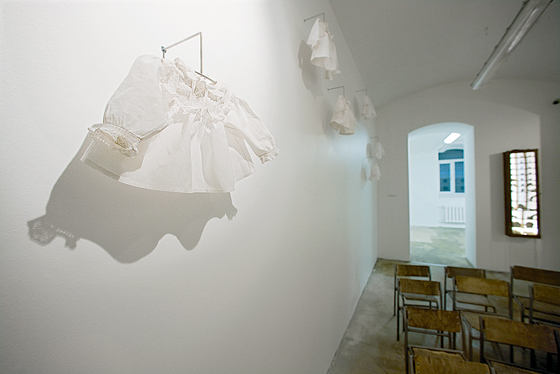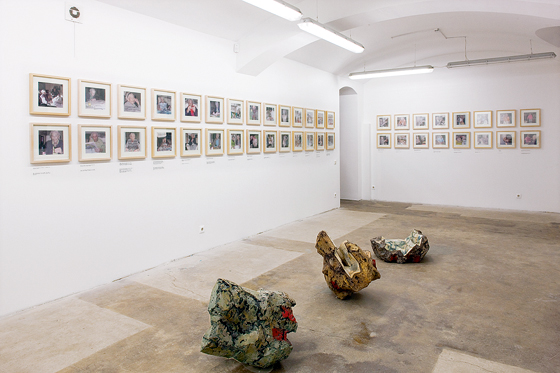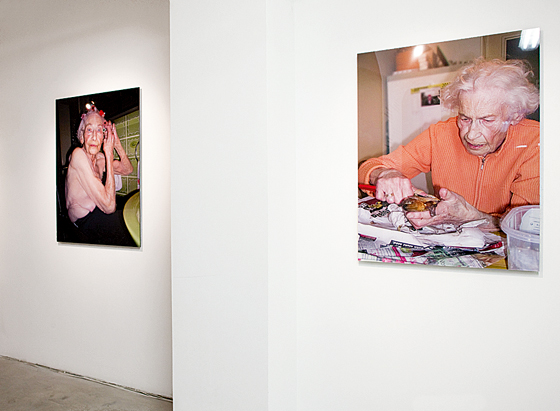|
|
| Wisdom of the heart Jānis Borgs, Art Critic Valda Podkalne. en face_vol. 3 12.01.–25.02.2012. Gallery 21 | |
| For many years we knew of her as the embodiment of excellence among porcelain artists, who had already reserved her place in the Olympus of art classics. For many years she had disappeared from our sight, and only occasional news informed that Valda Podkalne, this outstanding creative personality, was working in another country, and this sporadic information brought news of the artist’s energetic essence and vitality, and did not allow the otherwise accurate saying to become true – out of sight, out of mind. The interest in Podkalne’s art continued to linger. Now her home-coming has given concrete form to this interest, because Valda Podkalne has returned “with hands full” – a solo exhibition en face_vol. 3, which was open for viewing in Gallery 21 until the end of February. | |
 View from the exhibition of Valda Podkalne en face_vol.3. 2012 Photo: Didzis Grodzs | |
| Undoubtedly it was, once again, an enormous and pleasant surprise, but it was also completely different from what we had expected. Those who had come to see yet another exhibition of ceramics-based applied art could have been disappointed. Only a shade of Podkalne’s talent in ceramics could be sensed in the exhibition. But now, unexpectedly, we discovered an artist of much greater calibre of thought, who has been able to overcome the gravity of carefully honed craftsmanship and refined aestheticism and has launched herself into the orbit of philosophical heights. Here we encountered Valda Podkalne as a conceptually thinking author and multi-media artist, who addresses the viewer in the language of contemporary art. Her language is charged with poetic emotionality and is tense with drama. Behind the “lining” of the exhibition one could feel a huge stock of life experience and craftsmanship. This is not the easygoing and sparkling-like-champagne Podkalne we used to know. Now she also bears the weight of the trials of life and sedimentary rocks of thought, under whose pressure diamonds are formed. The artist has cut and polished these diamonds, and arranged them into a feast of spiritual enjoyment: en face_vol. 3. The nucleus of the exhibition is a dialogue between two women with completely different, however also in some way kindred, experiences. One of these women is Valda herself, with her nostalgic memories, but in contrast – en face – there is an 89 year old German woman facing the final years of her life. Fate brought these two women together in a relationship of “mother – daughter” during a time when Valda had assumed duties as caretaker and guardian angel of elderly people. The exhibition displayed a series of largeformat photographs of the elderly lady, where we could observe her daily activities in her solitary flat. Her image is revealed with a harsh and unembellished realism. Podkalne has allowed her camera lens to mercilessly witness the deterioration of the physical body caused by aging, contrasting it with the strength of the human spirit. The enormous degree of trust between the dialogue partners is revealed in several nude photos of the elderly lady, in which probably a formerly beautiful body has acquired its current form of disconcerting reality. This, it seems, is one of the biggest achievements of the exhibition – the ability to avoid any sentimental slavering. This is especially significant with regard to the artist, who has always stood out with aesthetic spirituality. However, her experience in the world of beauty has never pushed her even close to the precarious borderline of beauty or, in other words, to the “pink hole” (in analogy with the black hole), which has sucked in many a practitioner of the fine arts. | |
 View from the exhibition of Valda Podkalne en face_vol.3. 2012 Photo: Didzis Grodzs | |
| In an unusual approach, each photo of the old lady has been delicately supplemented with various quotes from her memories or nuggets of life wisdom. The artist has conscientiously written down some of their conversations, and now selected parts of the text appear in the photographs. This as if literary comic-book style combined with a visual story significantly enhances the revelations of the image and raises the emotionality of the overall mood. It should be noted that the texts played a decisively key role in Valda Podkalne’s en face_vol. 3 exhibition. This was also emphasized by the citations arranged in thought clouds at the beginning of the exhibition. The quotes used were by various well-known people about the significance of memories during a person’s lifetime and in its decline. Or the heart-warming and finely crafted object of metal strings with paper notes attached to them, which contained the dreams of the artist’s many friends. The texts here formed a kind of spiritual substance common to the whole of humankind, and it was these texts which directed the viewer towards a perception of the exhibition in the mood that Podkalne had intended. It was pleasing that the artist had not avoided using such textual applications and even didactical explanations, thus bravely leading us as if by hand into the world of contemporary art. Because for many viewers, contemporary art is still an environment of bewilderment or confusion. Although, from time to time, over-principled art purists may disapprove of such methods. Let us remember, however, that in the culture of Modernism (and especially Postmodernism) since the rise of the Cubists in the early 20 century there has been a successful “marriage” of text and image that exists in a constant dance of symbiosis. In Podkalne’s treatment, text gains a markedly conceptual value. Many contemporary artists quite frequently err in their attempts to present themselves as overly sophisticated intellectuals and philosophers, often sinking into pseudoscientific muddles and concepts, inflating a tiny nothing into a great big bubble. Valda Podkalne, in the wisdom of her heart and the depth of her knowledge, has successfully sailed past these underwater hazards. Podkalne also exhibited her multimedia skills in the video installation room, which symbolized the author’s childhood memories. The busy-bee activities of a small girl in the paradise of a summer garden was shown like a hazy vision of a tarnished old movie. It was a way of marking the tormenting distance of time between today’s agedness and an existence in the carefree weightlessness of joy long gone. This central image was even further intensified by the white baby angel dresses hung up at the walls, but this dangerously sweet metaphor was balanced out with the sobering image of kindergarten chairs in the viewer’s space. Their rusty condition returned us to reality and the recognition of the truth. The memories are there – in the kingdom of happiness, but we are here – in our present age. What an ingenious play with textures of time and zooming in and out! A truly cinematographic montage and a shrewd hockey of the imagination. | |
 Valda Podkalne. en face_vol.3. Installation. Fragment. 2012 Photo: Didzis Grodzs | |
| A range of objects pointed to the artist’s background in ceramics. The large abstract crumpled shapes of stone as if invited the viewer to the room with the images of the old lady as the idea centre of the whole exhibition. These shapes were reminiscent of packaging material discarded in the rubbish. Perhaps it’s not proper to look for similarities with reality in abstract art objects, but our intellectualism does not protect us from the flow of associations. And they (at least in the eyes of the author of this review) tell a tale of the unavoidable drama of life and the close proximity of death. Right here, just over the shoulder. Everyone was banished from paradise, everyone has to live through their own purgatory. Everyone will have to face the Big Transformation. A ceramicists skills came in useful when creating a “memory chest” in the style of a Fluxus box, filled with numerous fine porcelain abstract objects – wonderfully finely wrought miniatures. They most directly remind us of the keepsakes so commonly displayed on almost every person’s bookshelves or stored in the boxes tucked away by children, mothers or grandmothers… As a reference to the human tendency of hoarding things, Podkalne used a metaphysical 3D reproduction of a photograph of her parents’ wedding in a massive glass prism. In other parts of the exhibition the symbols of memory and experience were condensed into large “cocoon” shapes made up of a mass of stones. Here the viewer could also see the ceramic casts of the artist’s own hand in a rather grim-looking installation container, which brought associations of something medically surgical, or something to do with a Gestapo or KGB interrogation, or the chilly breath of Auschwitz, or it might have simply been the artist’s own reflection on the daily toil and the carrying of her own Cross… The revelations inspired by Valda Podkalne and her gaze en face into our souls tugged at our finest heartstrings, and continued to resonate in the depths of the heart long after the visit to the exhibition. And that is a rare thing, which in itself testifies to art with inestimable added value. /Translator into English: Vita Limanoviča/ | |
| go back | |







